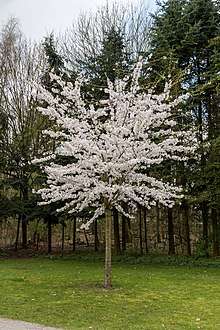Prunus serrulata
| Prunus serrulata | |
|---|---|
 | |
| Japanese cherry Prunus serrulata – Park Sentmaring, Münster | |
| Scientific classification | |
| Kingdom: | Plantae |
| Clade: | Angiosperms |
| Clade: | Eudicots |
| Clade: | Rosids |
| Order: | Rosales |
| Family: | Rosaceae |
| Genus: | Prunus |
| Subgenus: | P. subg. Cerasus |
| Section: | P. sect. Cerasus |
| Species: | P. serrulata |
| Binomial name | |
| Prunus serrulata | |
| Synonyms | |
| |
Prunus serrulata or Japanese cherry,[1] also called hill cherry, oriental cherry or East Asian cherry, is a species of cherry native to China, Japan, Korea and India[2], and is used for its spring cherry blossom displays and festivals. Current sources consider it to be part of a species complex with P. jamasakura and P. leveilleana, which have been reduced to synonyms.
Description
Prunus serrulata is a small deciduous tree with a short single trunk, with a dense crown reaching a height of 26–39 feet (7.9–11.9 m). The smooth bark is chestnut-brown, with prominent horizontal lenticels. The leaves are arranged alternately, simple, ovate-lanceolate, 5–13 cm long and 2.5–6.5 cm broad, with a short petiole and a serrate or doubly serrate margin. At the end of autumn, the green leaves turn yellow, red or crimson.
Flowers
The flowers are produced in racemose clusters of two to five together at nodes on short spurs in spring at the same time as the new leaves appear; they are white to pink, with five petals in the wild type tree. The fruit is a globose black drupe 8–10 mm diameter.
Cultivation
Prunus serrulata is widely grown as a flowering ornamental tree, both in its native countries and throughout the temperate regions of the world. Numerous cultivars have been selected, many of them with double flowers with the stamens replaced by additional petals.
In cultivation in Europe and North America, it is usually grafted on to Prunus avium roots; the cultivated forms rarely bear fruit. It is viewed as part of the Japanese custom of Hanami.
Varieties and cultivars
There are several varieties:
- Prunus serrulata var. hupehensis (Ingram) Ingram. Central China. Not accepted as distinct by the Flora of China.
- Prunus serrulata var. lannesiana (Carrière) Makino (syn. Cerasus lannesiana Carrière; Prunus lannesiana (Carrière) E. H. Wilson). Japan.
- Prunus serrulata var. pubescens (Makino) Nakai. Korea, northeastern China.
- Prunus serrulata var. serrulata (syn. var. spontanea). Japan, Korea, China.
- Prunus serrulata var. spontanea (Maxim.) E. H. Wilson (syn. Prunus jamasakura Siebold ex Koidz.)
Some important cultivars include:

- 'Amanogawa'. Fastigiate cherry, with columnar habit; flowers semi-double, pale pink.[3]
- 'Kanzan'. = 'Sekiyama', 'Kwanzan', or 'Kansan'. Kanzan Cherry. Flowers pink, double; young leaves bronze-coloured at first, becoming green.[3][4][5]
- 'Kiku-shidare'. Cheal's Weeping Cherry. Stems weeping; flowers double, pink. Tends to be short-lived.[3]
- 'Shirofugen'. = 'Shiro-fugen'. Flowers double, deep pink at first, fading to pale pink.[3][6]
- 'Shirotae'. Mt. Fuji Cherry. Very low, broad crown with nearly horizontal branching; flowers pure white, semi-double.[3][7]
- 'Tai Haku'. Great White Cherry. Flowers single, white, very large (up to 8 cm diameter); young leaves bronze-coloured at first, becoming green.[3]
- 'Ukon'. = 'Grandiflora', P. serrulata f. grandiflora Wagner. Green Cherry. Flowers semi-double, cream-white or pale yellow. Young leaves light bronzy-green. Fall leaf color can be purple or rusty-red.[3][8]

Gallery
 P. serrulata flowers
P. serrulata flowers Bark showing lenticels
Bark showing lenticels Leaf close up
Leaf close up Kurozome, the tree spirit of the Japanese Cherry Tree
Kurozome, the tree spirit of the Japanese Cherry Tree Cultivar flower close up
Cultivar flower close up Prunus serrulata – Cherry blossoms
Prunus serrulata – Cherry blossoms- Buds on cultivar 'Kanzan'
- Flowers on 'Kanzan'
- Typical autumn foliage
- 'Ukon' (Prunus lannesiana Wilson cv. 'Grandiflora')
References
- ↑ "BSBI List 2007". Botanical Society of Britain and Ireland. Archived from the original (xls) on 2015-01-25. Retrieved 2014-10-17.
- ↑ https://www.india.com/photos/travel/first-cherry-blossom-festival-of-india-kick-starts-in-shillong-7-facts-about-cherry-blossoms-you-didnt-know-85900/cherry-blossoms-are-not-necessarily-pink-in-color-85902/
- 1 2 3 4 5 6 7 Arthur Lee Jacobson. "Plant of the Month: April 2005: Japanese Sato zakura in Seattle: Prunus cultivars". Retrieved 21 October 2011.
- ↑ "Prunus 'Kanzan' AGM". Plant Selector. Royal Horticultural Society. Retrieved 30 March 2018.
- ↑ "Prunus 'Kanzan'". Missouri Botanic Garden. Retrieved 30 March 2018.
- ↑ "Prunus 'Shirofugen'". Plant Selector. Royal Horticultural Society. Retrieved 30 March 2018.
- ↑ "Prunus 'Shirotae'". Missouri Botanic Garden. Retrieved 30 March 2018.
- ↑ "Prunus 'Ukon' AGM". Plant Selector. Royal Horticultural Society. Retrieved 30 March 2018.
Further reading
- Rushforth, K. (1999). Trees of Britain and Europe. Collins ISBN 0-00-220013-9.
- Flora of China: Cerasus serrulata
- NC State University: Prunus serrulata
- Arborist's photo: size potential for Prunus serrulata 'Shirotae' ('Mt. Fuji')
External links
| Wikimedia Commons has media related to Prunus serrulata. |